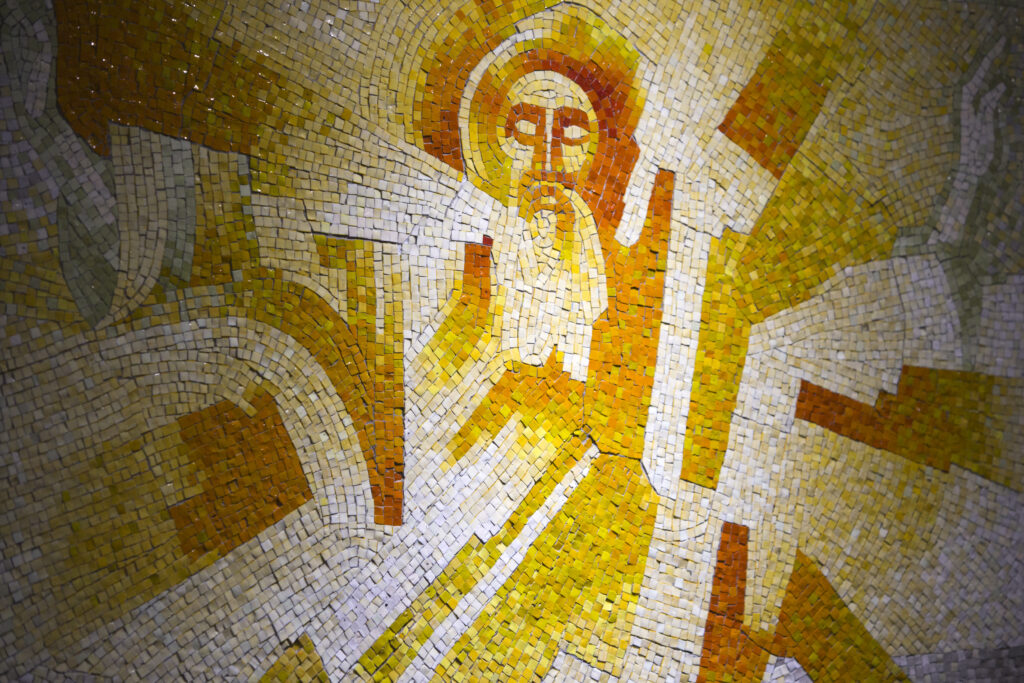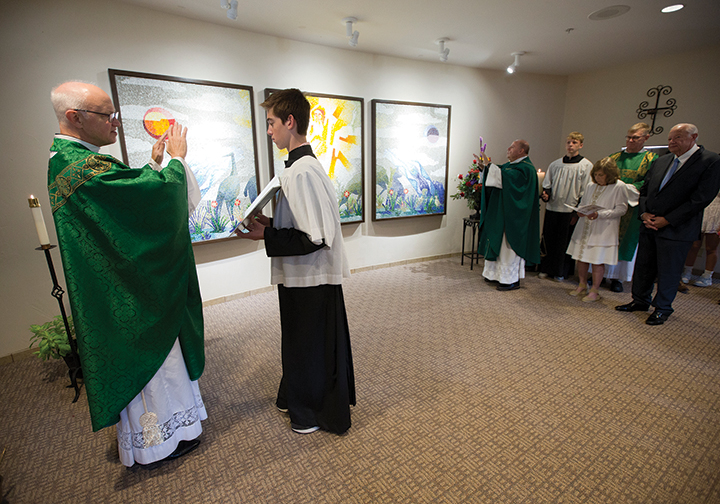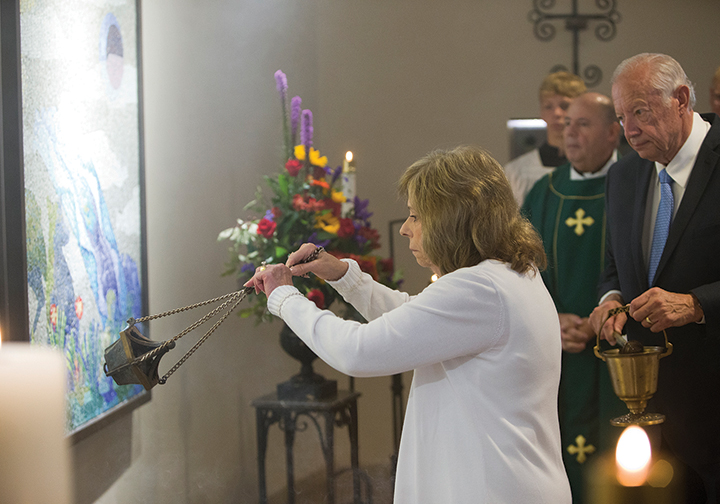
by Joe Bollig
joe.bollig@theleaven.org
LAWRENCE — The new, three-panel mosaic at Corpus Christi Parish here is made of 48,000 fingernail-sized bits of colored glass. And if they weren’t securely cemented in place, it would be chaos.
Chaos, creation and the order intended by God were themes in the homily preached by pastor Father Jerry Volz at a Mass on Sept. 17 that included the blessing and dedication of the new mosaic called “Creation” installed in the church entryway, or narthex.
“Out of the chaos or nothingness (described in the Book of Genesis), God created beauty, and when God created beauty, that again was God’s intention that it would always be beautiful,” said Father Volz. “That our world and all within it — and especially our human nature — would return to that beauty.”
If you were to take all 48,000 pieces of glass tile in the new mosaic and just throw it out onto the floor it would be chaos, he said. Not what God intended.
That’s why so many artists and poets call God “the divine artist,” said Father Volz.

The three mosaic panels — each 4 feet by 5 feet — are on the wall to the right as one enters the church. On the wall to the left is another mosaic, a glazed tile work called “Communion of Saints,” blessed and dedicated in 2017.
Together, the mosaics flanking the entrance of the church represent the beginning (“I believe in one God, the Father almighty, maker of heaven and earth . . .”) and end (“. . . the communion of saints . . .”) of the Nicene Creed. “Creation” is made of enameled glass called “smalti” and made in Italy.
Both mosaics were made by the Emil Frei & Associates studios in Kirkwood, Missouri, near St. Louis.
An artistic tradition
It was always intended that another mosaic would be made to complement the “Communion of Saints,” so in 2019 Tom and Marilyn Dobski, parishioners since 1992, approached then-pastor Father Mick Mulvany about commissioning a new mosaic. Together, Father Mulvany, now pastor of Holy Family Parish in Eudora, and the Dobskis worked with lead artist William Frank of Emil Frei to develop a design.

The project ran into delays — first, by a time of transition between Father Mulvany and Father Volz, and second by the COVID-19 pandemic.
The Dobskis’ effort was part of a long tradition at Corpus Christi of beautifying the church and school with art. The custom started with Father James Shaughnessy, who oversaw the building of the present campus, and was carried on by his two successors.
“The church continues a rich tradition of artistic expression that dates to the earliest Christian communities,” said Father Mulvany. “This tradition has consistently contributed to the cultivation of the faith, the beautification of worship spaces and the fostering of a sense of unity among believers.”
“Artists have the ability to create art that is relevant to contemporary culture while maintaining a connection to the timeless teachings of the church,” he added. “This dynamic combination helps bridge the gap between the ancient and modern, making the Gospel message accessible to people of all ages.”
Giving the best
The blessing and dedication of “Creation” took place just before the Mass held Sept. 17. Both Father Volz and Father Mulvany led prayers and blessed the mosaic with holy water and incense. The Dobskis were also given the opportunity to bless the artwork.

Marilyn couldn’t have been happier with the end result of their philanthropy.
“It’s gorgeous, absolutely,” she said. “You have to get close up to it to actually see the 48,000 pieces of glass that make up the mosaic. . . . It’s such a tremendous project.”
Among the earliest Christian artwork to be discovered are mosaics in the church of Santa Costanza in Rome, built in approximately 320. The oldest surviving Christian church frescoes are in the baptistry of the converted house-church, painted about the year 232, at Dura-Europos in Syria.
“We want to give the best to God, especially in our churches,” said Father Volz. “God is housed [in the Blessed Sacrament] in our churches. We give glory to God, giving the best to the best . . . mosaics, especially. They won’t fade and hopefully won’t fall apart. It’s symbolic of that eternal glance toward God.”
During this year of Eucharistic Revival, Corpus Christi Parish will host tours of the church and campus religious art. Tours will be offered on the first Wednesday of the month at 9 a.m. and on the first Saturday of the month following the 4 p.m. Mass.






